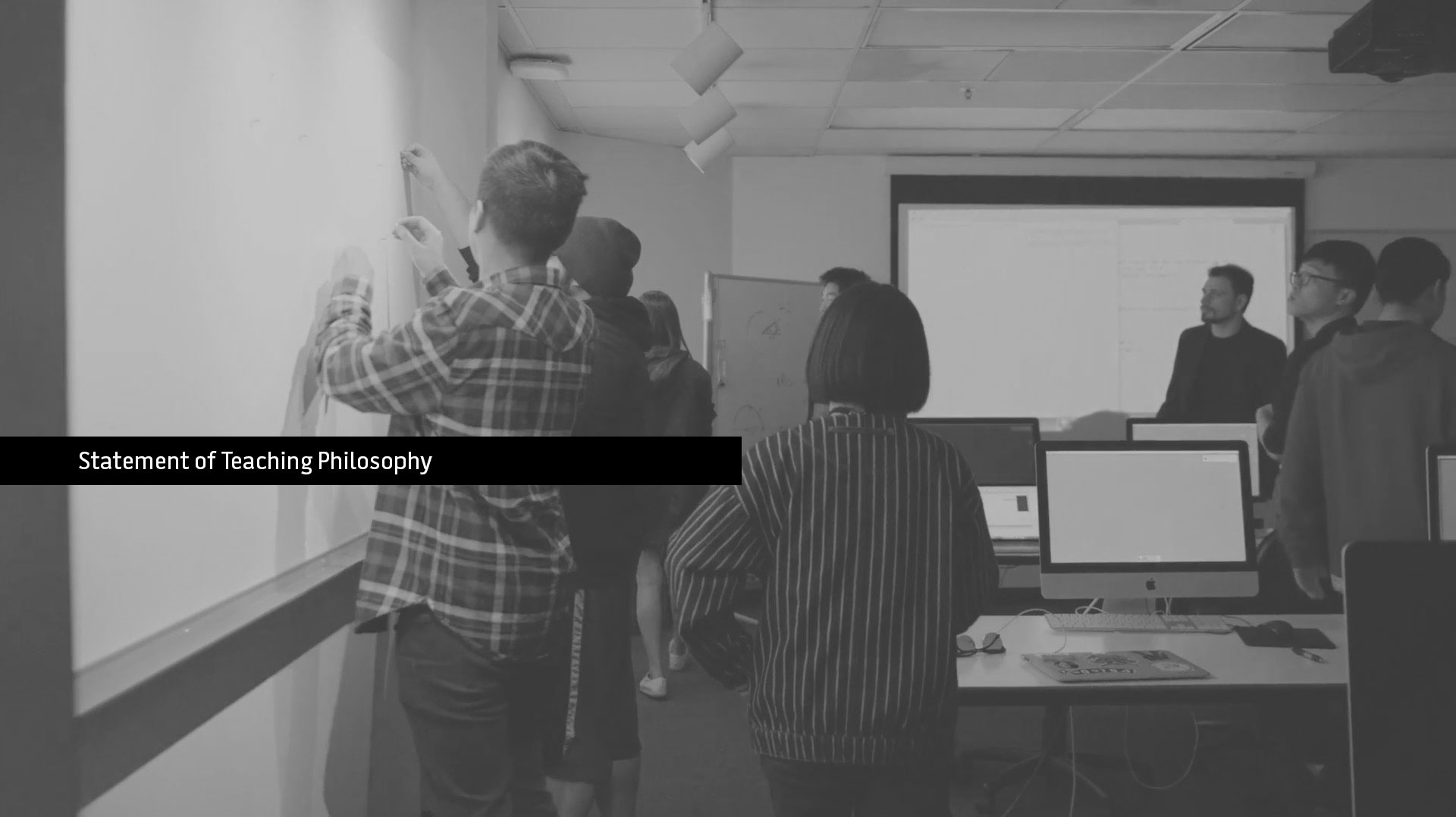Instruction Overview

From 2008–2019, I’ve been a professional design educator. And since 2012, I’ve been the lead instructor and a faculty member in the school of Web Design & New Media, at the Academy of Art University, San Francisco. Using my technical, design, and educational knowledge, I provide support and instruction for nearly 800 students across both undergraduate and graduate level studies. I try and do it with patience.
My course load is to instruct six courses in the Fall/Spring Semester, and three in the Summer, which a little back of the napkin math means 15 total a year. Although I began as a motion graphics design specialist, and that remains my title (Motion Graphics Lead), I’ve attempted to make myself as useful as possible to my program. For me, this has meant teaching multiple levels and getting up to speed on multiple subjects, up and down the curriculum map. In my time at AAU, I’ve instructed 20 different courses offerings, taught 151 classes (included directed study). With each class meeting 15 times, this means I’ve had 2,265 sessions (“modules”), or 6,795 hours of just in classroom time.

They say the job ages you.
Acquiring the knowledge base to support so many courses has meant many hours invested into small and large books. Like many designers, my book collection kind of morphed into a library when I wasn’t paying attention. I set up a database and web portal to loan out the books to interested students as an additional learning resource. Student are urged to consider the pursuit of knowledge as part and parcel to the practice of design.
I’ve also used my training as a designer to create my courses. I’ve done a lot of primary and secondary information sourcing to determine what should be included and what should be omitted. Authoring a great course means identifying the desired outcomes and then tracking back to the actions required to get there, just like great interactive design. As the course unspools with each group of students it is in a constant state of refinement to see if it is possible to eke out a bit more understanding and performance from the participants. This process is particularly fruitful if I’m not the instructor, and there is much to be learned when engaging with the part-time instructors who present material I’ve provided. The course learning outcomes (CLOs) are then stacked to see if they build a solid foundation for the wall of understanding that are the program learning outcomes (PLOs).
An interest in the material is where most design educators start, but duplicating results across a student population of differing backgrounds and experiences is the real challenge. I’ve authored rubrics that are consistent and stress-tested to get a sound assessment strategy, and that has be essential to strengthening our program. I’ve done this with the help of the fantastic education support specialists at my institution, who were able to help me translate my “design” speak into “edu” speak.
Being a teacher means letting go of your own design practice in some ways. Your work no longer becomes something tangible that fits nicely into a Behance post. Your work, instead, is to design a system that creates… well… thought itself in the head of someone else. Your work is creating an environment that favors progression and connection as opposed to checklists and “deliverables”. Your work is about creating a design simulation machine for students to do test flights in.
Your work is being present for others.
I’ve also come to learn more about education strategies and my pedagogical approach has undergone a slow tectonic shift during my time teaching. It’s difficult when you have a passion for the material. You are the content specialist, and it’s easy to fall into a trap of showing the students how knowledgeable you are. But students are not evaluated by how much the instructor knows. Migrating my philosophy and approach towards student-centered learning as opposed to a top-down structure has not just yielded better results, but it empowers students to take responsibility of their own design practice.
To paraphrase Josef Albers, teaching isn’t really a matter of knowledge, but a matter of heart. A good teacher provides sufficient answers. An amazing teacher provides sufficient questions.
Here’s an overview of some of the student work and the courses I’m most responsible for.
WNM205: Motion Graphics 01
This undergraduate course introduces the theory and production of animated graphics for multiple platforms. Concept, research, visual, and production techniques for motion graphics projects are covered, focusing on animating with typography, graphic symbols, shapes, and color. Industry leading software (you know, After Effects) are employed with an emphasis on classic animation principles and workflow.
>learn more at the course home page
WNM498/699: Generative Art & Code
This course focuses on generative art, “creative coding”, and implementing emerging technologies. Students will employ industry‐standard methods, tools, and workflow to create, design, and animate within the browser and other programming environments (currently, p5.js and Processing) The goal of programming in the course is not implementation or software development but using code as a tool for creative exploration and self‐expression. Webtech, workflows, testing, and iterations will be covered.
tl;dr Students learn to make art using code.
>learn more at the course home page
WNM700: Human Centered Design Approach
This capstone level graduate course will introduce the concept of human–centered design and how this approach can be used to create innovative, effective and sustainable solutions. The primary purpose of the course is to provide an opportunity to build problem–solving skills and explore “design thinking”.
In many ways, the purpose of this class is to fail, and then show the learning from that failure.
>learn more at the course home page
Here’s

